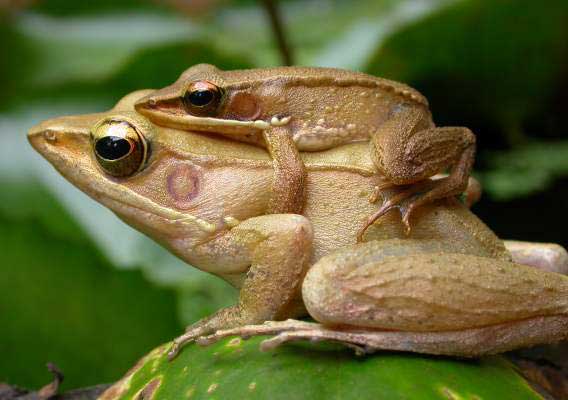Hylarana temporalis in amplexus (*) Cladus: Eukaryota Name Hylarana temporalis (Günther, 1864) Type locality: "Ceylon" (= Sri Lanka). Syntypes: BM 52.2.19.43-44, 58.10.15.5-6, 53.7.19.11 & 58.10.15.18. Synonyms * Rana flavescens Jerdon, 1854 References * Günther, 1864, Rept. Brit. India: 427. Vernacular names
---------- The Bronzed Frog (Hylarana temporalis) is a frog species found in the riparian evergreen forests of the Western Ghats, India and the highlands of Southwestern Sri Lanka. They are found abundantly on or close to the ground near water. Individuals are not shy and react by jumping only when provoked. They are important prey of many species of snakes including the Malabar Pit Viper and the Vine Snake.
Etymology The frogs' common name is derived from the small bronze coloured strips that appear on either side of the lower jaw, between the snout and the posterior point of the forelimbs within a week after metamorphosis.[4] The species has been referred to by several names including Hylarana malabarica(non-Tshudi),[5] Rana flavascens(Jerdon),[6] Rana malabarica(Gunther),[7] Hylorana malabarica(Gunther),[8] Hylorana temporalis(Gunther),[9]Hylorana flavescens(Jerdon),[10]Rana temporalis(Bouleng),[11] Sylvirana temporalis etc. Distribution and habitat H.temporalis is distributed throughout the Western ghat mountains of South India, along Kerala, Tamil Nadu, Karnataka and Maharashtra at an elevation of 200–1800 m and the wet forests of southwestern Srilanka at an elevation of 60–1830m. The individuals are chiefly found on edges of rocky streams at low altitude. It sits exposed on flat rocks and stones and leaps, often to a considerable distance, into the water when disturbed.[12] Breeding The Bronzed Frog typically breeds along the edges of gently-flowing and/or in pockets of still water along the streams. The muddy colour of the tadpoles matches well with the substratum of the stream. The oral armature is well-suited for grazing at the bottom. In near permanent water, the tadpoles may have longer metamorphic duration (3–4 months)to enable body growth and emergence of larger/stronger froglets.[13] Growth and Development The tadpoles of H. temporalis start appearing in the streams by October till March. They are at least 11–14 mm long at metamorphosis and weigh about 100–170 mg. The larval duration varies from 90–120 days. The dorsal side of the tadpoles bear a muddy green/white/yellowish or olive brown colour while their lateral side is usually muddy. They carry a triangular snout with a single, sinistral and lateral Spiracle. Tail fin is transparent and pointed with moderately developed musculature. Slight pigmentation is visible on the skin of tail muscles and tail fins. The height of the dorsal fin is greater than the ventral fin. The teeth are blunt with the dental formula 2(2)/3(1). A characteristic yellowish brown strip is formed on the dorsal side between the snout and the posterior tip. On the lateral side, a black strip runs from the anterior to the posterior side of the body. Within a week of metamorphosis, small bronze coloured strips appear on either sides of the lower jaw, between the snout and the posterior point of the forelimbs. The bronze strips are interrupted below the forelimbs.[14] Effects of Density and Kinship on Growth and Metamorphosis Density can significantly influence growth and metamorphosis in many species of anurans like the Indian bull frog(Rana tigrina) and the toad B.melanostictus, including the Bronzed Frog. Studies show that generally growth rates, measured in terms of body mass, vary inversely with population density, and slowly growing individuals metamorphose at smaller sizes than their larger conspecifics. Growth and size at metamorphic climax were therefore inveresly correlated with density of rearing. Interestingly, presence of kin and non-kin also affects larval growth and metamorphosis. Larval growth where significantly greater when reared with siblings(crowded or uncrowded) compared to those reared with non-kin. Also variation in size was also lower in individuals reared in pure groups compared to those reared in mixed groups. In mixed groups, the spectrum of developmental stages were broader vis-a-vis pure groups.[15] Behaviour Microhabitat Choice Following the south-west monsoon rains that lashes the Indian west coast from the first week of June, innumerable anuran species co-breed in ephemeral ponds and puddles.[16] This incidentally puts the individuals in severe intra- and interspecific competition for food and space and also to predation pressures. Microhabitat selection is therefore an important strategy employed by the anuran species including the Bronzed frog. Experiments show that tadpoles of R.temporalis which possesses a ventral mouth, predominantly prefers to occupy the substrate zone and that the number of individuals that exercise this preference is greater in the night than in daytime.[17] Social Aggregation Tadpoles of R. temporalis show social aggregation phenomenon. However, the nature and significance of this behaviour is yet to be understood. Kin Recognition Kin recognition is a phenomenon widespread in organisms as diverse as social insects, fishes, amphibians, birds, and mammals and even plants. Kin recognition behaviour in Bronzed Frog seems to be associated with growth regulation as their growth and metamorphosis is enhanced when reared with siblings than with non-siblings.[18] Foraging Strategy Ideal Free Distribution(IFD) refers to the idea that individuals of a species will distribute themselves amongs areas or patches in such a way that the average gain to all individuals is equal.[19] Studies have shown that tadpoles of Bronzed Frog exhibit IFD behaviour while foraging regardless of whether they are siblings of non-siblings in a group, which correlates well with their group-living strategy in nature.[20] Food Perception Studies on individual test tadpoles of Bronzed Frog suggest that food is detected based on chemical cues and not visually indicating that chemical perception predominates visual senses in R. temporalis tadpoles.[21] References 1. ^ Biju et al. (2004). Rana temporalis. 2006. IUCN Red List of Threatened Species. IUCN 2006. www.iucnredlist.org. Retrieved on 11 May 2006. Database entry includes a range map and justification for why this species is near threatened Source: Wikipedia, Wikispecies: All text is available under the terms of the GNU Free Documentation License |
|

